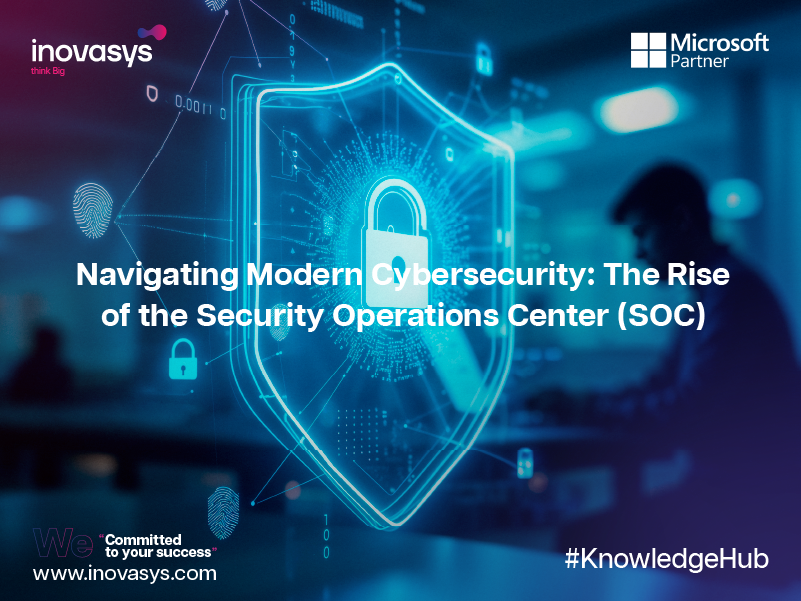Inovasys, founded in 2014, has been a leader in providing advanced technology solutions. By 2020, it became known as a service provider. The company aims to be the best partner for businesses looking to improve their operations with digital technology.
Articles & Press Release

Navigating Modern Cybersecurity: The Rise of the Security Operations Center (SOC)
In a world of ever-evolving and increasingly complex cyber threats, traditional security measures are no longer enough. The growing use of cloud services, the proliferation of IoT devices, and the rise of sophisticated attacks like ransomware have created a pressing need to move from a static, prevention-focused approach to a dynamic and intelligent security model. This shift demands the expertise and advanced technology of a professional Security Operations Center (SOC) to protect modern digital infrastructure.
The Role of a Professional Security Operations Center (SOC) in Cybersecurity:
In light of the escalating and complex cyber threats, traditional protection tools like firewalls or antivirus software are no longer sufficient on their own to secure digital infrastructure. With the expanding use of cloud services, the increasing reliance on IoT, and the rise of targeted attacks such as ransomware and zero-day attacks, it has become essential to transition from a static, traditional protection model to a more dynamic and intelligent one that relies on professional Security Operations Centers (SOCs) supported by modern technologies.
Traditional Protection: Limits and Constraints:
- Focus on Prevention Only: Traditional protection tools are limited to blocking without advanced monitoring of internal activities
- Vulnerability to New Attacks: They often rely on signatures, which makes them helpless against previously unknown threats.
- Lack of Comprehensive Visibility: These tools have difficulty monitoring a hybrid environment that includes devices, cloud applications, and distributed networks.
- Limited Human Reliance: In many organizations, internal security teams are small and unable to respond immediately to large-scale attacks.
The Role of a Professional SOC
A Security Operations Center (SOC) is the central brain for cybersecurity in an organization, integrating:
- Continuous 24/7 monitoring.
- Early threat detection through advanced techniques like behavioral analysis and artificial intelligence.
- Coordinated and rapid response through immediate containment procedures for attacks.
- Incident management and digital forensics to understand the root of the attack and address it from the source.
How an SOC Supports a Smart Response
-
SIEM (Security Information & Event Management) Systems: These collect and analyze system and network logs to monitor for unusual patterns.
-
MDR (Managed Detection & Response) Services: These enable the detection and response to advanced threats through specialized external teams.
-
SOAR (Security Orchestration, Automation, and Response): This automates response steps to reduce incident handling time from hours and days to minutes and seconds.
-
Threat Intelligence: This provides the SOC with live information about the latest attacks and hacker tools, which increases the accuracy of the response.
Benefits of Transitioning to an SOC Strategy
-
Comprehensive and integrated visibility across cloud and on-premises work environments.
-
A faster and more effective response that reduces attack losses.
-
Relieving pressure on internal teams by relying on specialized external expertise.
-
Improving compliance with international standards such as ISO 27001, GDPR, and NCA.
-
Continuously raising the organization's security maturity level.
Challenges for Organizations
-
Initial Cost: Establishing an in-house SOC can be very expensive.
-
Lack of Expertise: There is a global shortage of cybersecurity experts.
-
Managing Complex Environments: Organizations operating across multiple countries and markets need an SOC that can handle diverse contexts.
The Solution: Managed SOC
The optimal solution for many organizations is to use a professional service provider that offers a managed SOC, which combines:
-
Advanced infrastructure.
-
Specialized human expertise.
-
AI and automation technologies.
This allows organizations to get advanced, scalable security without bearing the burden of establishing and operating a costly in-house SOC.
Frequently Asked Questions (FAQs)
Q1: What is the primary difference between traditional security tools and an SOC?
Traditional tools like firewalls are primarily focused on prevention and blocking known threats, whereas a Security Operations Center (SOC) provides continuous, 24/7 monitoring, active threat detection, and rapid response to both known and unknown threats across your entire digital environment.
Q2: What is a Managed SOC, and how does it help a business?
A Managed SOC is a Security Operations Center provided by a third-party service. It allows a business to access advanced security infrastructure and expert cybersecurity professionals without the high cost and complexity of building an in-house team. It helps companies get proactive, scalable protection against cyberattacks.
Q3: How does an SOC handle new cyber threats like ransomware and zero-day attacks?
An SOC uses advanced technologies like SIEM for analysis, MDR for detection and response, and Threat Intelligence to stay ahead of new attacks. This allows it to identify and respond to threats that traditional signature-based tools would miss, such as a new ransomware variant or a zero-day exploit.
Q4: What are the main benefits of moving to an SOC-based strategy?
The key benefits include achieving comprehensive visibility across your systems, enabling a faster and more effective response to incidents, reducing the workload on internal teams, and improving compliance with major security standards like ISO 27001 and GDPR.

